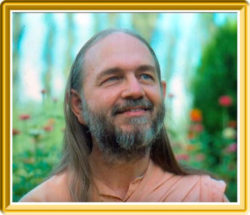The Father of Yogananda’s Community Movement
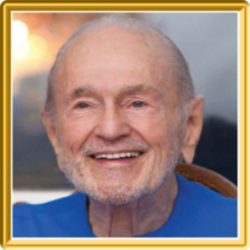
Swami Kriyananda (James Donald Walters) was a direct, close, and important disciple of Paramhansa Yogananda. He created, in his Guru’s name, a work distinct from that of Self-Realization Fellowship (SRF): the Ananda communities. Some fellow disciples therefore accused him of being a “Judas”.
He viewed his Gurus’ mission in wide-ranging terms and was determined to take his teachings to every corner of society, using creative, expansive, innovative means. However, Daya Mata (the SRF president) understood her duty to be just the opposite: to preserve the purity of Yogananda’s teachings. She stated: “This is why you see that neither Daya Ma nor any of these other disciples have attempted or presumed in any way to change or to dilute with personal innovations what he taught.” They regarded SRF as the sole legitimate instrument of Yogananda’s legacy, perceiving Kriyananda as disloyal, ego-motivated and misguided.
Others saw him in a vastly different light. For example, Hare Krishna Gosh, Yogananda’s nephew, stated: “Of all Yogananda’s disciples, I consider Swami Kriyananda the highest in wisdom.”
His impact on people was undeniable. Many devotees who experienced his influence on their lives had no doubt that they were in the presence of a saint (free book Swami Kriyananda As We Have Known Him).
Who was Swami Kriyananda? What was the cause of these completely opposing perceptions of him?
As we shall see, he was a highly energetic, creative, and successful disciple of Yogananda. Before falling into official disgrace, for 14 years he had been a prominent and much-loved teacher in SRF, both during and after Yogananda’s lifetime. His development within SRF was impressive, like a bush blossoming with many flowers. Then, with devastating fury, lightning struck, burning everything to ashes. From those ashes, however, a new plant gradually emerged and flourished.
But before continuing, we need to know a little of the background.
Family and ancestry
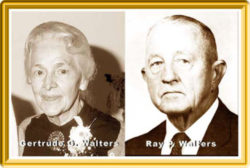 Swami Kriyananda was born in Teleajen, Romania, on Sunday May 19, 1926 as James Donald Walters, to American parents. His father, Ray Pearce Walters (Jan.14, 1898- Feb.12, 1983), was a pioneering geologist; his mother, Gertrude G. Walters (Sept. 27, 1899-July 1983), was a deeply religious woman, who received a personal blessing from Yogananda when she visited Mount Washington. Throughout her pregnancy with Kriyananda, Gertrude was inwardly filled with joy. “Lord,” she prayed repeatedly, “this first child I give to Thee.”
Swami Kriyananda was born in Teleajen, Romania, on Sunday May 19, 1926 as James Donald Walters, to American parents. His father, Ray Pearce Walters (Jan.14, 1898- Feb.12, 1983), was a pioneering geologist; his mother, Gertrude G. Walters (Sept. 27, 1899-July 1983), was a deeply religious woman, who received a personal blessing from Yogananda when she visited Mount Washington. Throughout her pregnancy with Kriyananda, Gertrude was inwardly filled with joy. “Lord,” she prayed repeatedly, “this first child I give to Thee.”
Two younger brothers soon joined the family: “Bob, Bucky” Robert Walters (1927-around 1980), and “Dick” Richard Francis Walters, (1930- 2021)
Already as a child, Kriyananda revealed a philosophical and cosmopolitan mentality, which might be due to his upbringing and schooling in diverse cultures: Romania, Switzerland, England and USA (Haverford College and Brown University). He was fluent in several foreign languages: Romanian, French, Italian, German, Bengali, and Spanish.
His attitude of “the world is my home, and the human race my family” might have also been the result of his varied ancestry, which stemmed from “England, Wales, Scotland, Ireland, Holland, France, and Germany.” (The New Path). He later composed many pieces of music to express the mood of some of these cultures and of numerous others. In addition, there was the “soul ancestry”: he remembered a past life in Egypt and one in medieval England. Yogananda told him he had been a yogi “many times”.
Childhood and youth
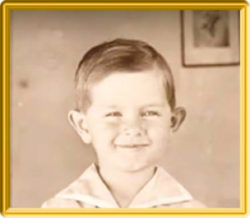 Already as a child he experienced the effects of these past yogic lives:
Already as a child he experienced the effects of these past yogic lives:
“My clearest early memories all relate to a special kind of happiness, one that seemed to have little to do with the things around me, that at best was only reflected in them. A lingering impression is one of wonder to be in this world at all. What was I doing here? Intuitively I felt that there must be some higher reality—another world, perhaps, radiant, beautiful, harmonious, in relation to which this earthly plane represented mere exile. Beautiful sounds and colors thrilled me almost to ecstasy. Sometimes I would cover a table down to the floor with a colorful American Indian blanket, then crawl inside and fairly drink in the luminous colors. At other times, gazing into the prism formed by the broad edge of a mirror on my mother’s dressing table, I would imagine myself living in a world of rainbow-colored lights. Often also, at night, I would see myself absorbed in a radiant inner light, and my consciousness would expand beyond the limits of my body.” (The New Path)
Donald was a child with an ever-questioning mind. In his adolescence this became a constant quest for truth.
Significantly, even as a teenager he contemplated creating communities as an ideal solution for our planet. During college he was an aspiring playwright and wrote a play about it, later called The Peace Treaty. Community-building in fact turned out to be the central theme of his life.
However, his inner quest for truth – which he finally understood as quest for God – at first took him in the very opposite direction: “I must seek God in the wilderness, on a mountaintop, in complete solitude. I would become a hermit.”
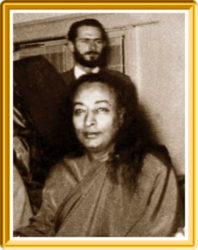 Fate decided differently, however. In September 1948, he discovered the Autobiography of a Yogi, which represented the turning point of his life. The book resonated in his innermost being, in his soul: “As I read Autobiography of a Yogi, I alternated between tears and laughter: tears of pure joy; laughter of even greater joy! For three days I scarcely ate or slept. When I walked it was almost a tiptoe, as if in an ecstatic dream.” The result was life-transforming: “Autobiography of a Yogi remains the greatest book I have ever read. One perusal of it was enough to change my whole life. From that time on, my break with the past was complete. I resolved in the smallest detail to follow Paramhansa Yogananda’s teaching.”
Fate decided differently, however. In September 1948, he discovered the Autobiography of a Yogi, which represented the turning point of his life. The book resonated in his innermost being, in his soul: “As I read Autobiography of a Yogi, I alternated between tears and laughter: tears of pure joy; laughter of even greater joy! For three days I scarcely ate or slept. When I walked it was almost a tiptoe, as if in an ecstatic dream.” The result was life-transforming: “Autobiography of a Yogi remains the greatest book I have ever read. One perusal of it was enough to change my whole life. From that time on, my break with the past was complete. I resolved in the smallest detail to follow Paramhansa Yogananda’s teaching.”
Kriyananda didn’t know it then, but just three month earlier, in June 1948, Yogananda had experienced what became known to disciples as his “great samadhi”. During this ecstasy, Divine Mother spoke both to him and through him, uttering also these words: “In the beginning, I sent you a few bad ones to test your love for Me. But now I am sending you angels, and whoever smites them, I will smite!” Kriyananda was the very next disciple who joined the Master’s fold.
At any rate, the day after having finished the Autobiography of a Yogi, aged 22, Kriyananda took a bus from New York to Los Angeles, leaving everything behind him, certain that Yogananda would give him all he had ever been looking for.
At SRF under Yogananda (1948-1952)
On 12 September 1948, Kriyananda met Yogananda in his beautiful Hollywood Church. At first he was told that the Master wasn’t going to receive any newcomers. His schedule was full for the next three months. Suddenly, however, Yogananda called him in: “I agreed to see you only because Divine Mother told me to.” He accepted Kriyananda immediately as a disciple, telling him, “You have good karma.” Then he expressed words never to be forgotten: “I give you my unconditional love.” On that day of arrival, during the very first interview, the great Guru had Kriyananda take the vows of discipleship and renunciation. It was unheard of. The reason for it, as Yogananda later said, was that he had been his disciple “for a long time.”
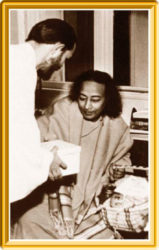 In January 1949 the Master put him into office work, answering letters.
In January 1949 the Master put him into office work, answering letters.
Soon afterwards, he made him the official examiner of the students’ answers to the questions which were given in those days in the SRF Lessons. Writing was Kriyananda’s passion anyway.
In fact, in March 1949, six months after joining, Yogananda asked him to start writing articles, to “spruce up” his SRF magazine. He used the pen name Robert Ford.
More was to come. In May 1949, only eight months after their first meeting, the Guru asked Kriyananda to shoulder a major responsibility: he authorized him to bestow the sacred Kriya initiation. This was unprecedented: nobody else had ever received that sacred trust so soon from the Master.
Similarly, after only eight months, Yogananda asked Kriyananda to begin to publicly share his teachings. His first talk (a frightening experience) at the SRF San Diego Church was one which the Master himself was scheduled to give. Instead he asked his young disciple to appear in his place. From then on Kriyananda lectured regularly in the SRF San Diego Church and the SRF Hollywood Church.
Kriyananda at first resisted this public role: “Sir, I don’t want to be a public speaker.” Yogananda however gave him no room for choice: “You’d better learn to like it. That is what you will have to do.” And he gave him an important reassurance: “You will never fall because of ego!”
Yogananda instructed him (calling him Walter): “Your work will be lecturing, editing, and writing.” In fact, in January 1950 the Master took him to his desert Retreat (29 Palms) to help him edit his books. “I asked Divine Mother whom I should take, and your face, Walter, appeared before me. I asked Her twice more, to make sure, and each time your face appeared.” He therefore took editing as a life-long task, given to him by his Master, who told him in May 1950: “I predict you will make a good editor someday, Walter.” Of course this became a source of subsequent disagreement.
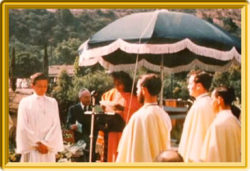 In 1950 Yogananda ordained “Reverend Walter” as a SRF minister. In time, he became the most well-known teacher of SRF, traveling nationally and internationally.
In 1950 Yogananda ordained “Reverend Walter” as a SRF minister. In time, he became the most well-known teacher of SRF, traveling nationally and internationally.
In May 1950, the Master began urging Kriyananda to write down his words during informal conversations. These notes were later compiled in two books, The Essence of Self-Realization and Conversations With Yogananda.
Also in 1950, Yogananda made him the head of the SRF monks, even though he was still very young. In other words, he gave Kriyananda the difficult job of being in charge of monks who were his seniors, both in age and in length of discipleship. He counseled him to lead with a light hand: “Don’t make too many rules, they destroy the spirit.” Kriyananda later wrote the booklet “Give Me Thy Heart,” for devotees applying to become SRF monastics. It is still being used today in some form.
In March 1952, just three days before he left his body, Yogananda lovingly told Kriyananda: “You have pleased me very much. I want you to know that.” These were precious words, forever engraved in his heart.
Kriyananda was present when Yogananda entered mahasamadhi during a banquet at the Biltmore Hotel on March 7, 1952. The Master had personally asked Kriyananda to come to the event.
At SRF under Rajarsi Janakananda (1952-1955)
In 1953, with Rajarsi’s approval, Kriyananda was given the position as head of the Center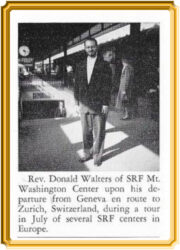 Department (meditation groups). In this capacity he travelled to Mexico in 1954 and, in 1955, visited groups in America, Eastern Canada and Europe. Here Kriyananda visits Oliver Black, SRF Detroit.
Department (meditation groups). In this capacity he travelled to Mexico in 1954 and, in 1955, visited groups in America, Eastern Canada and Europe. Here Kriyananda visits Oliver Black, SRF Detroit.
In Summer 1954, aged 29, he featured at the SRF Convocation as an impromptu and fun Indian story teller, as we can read in the Self-Realization Magazine, Sept, 54, page 27.
In July 1955 “Rev. Donal Walters” was featured on the cover of Self-Realization Magazine as a traveling minister.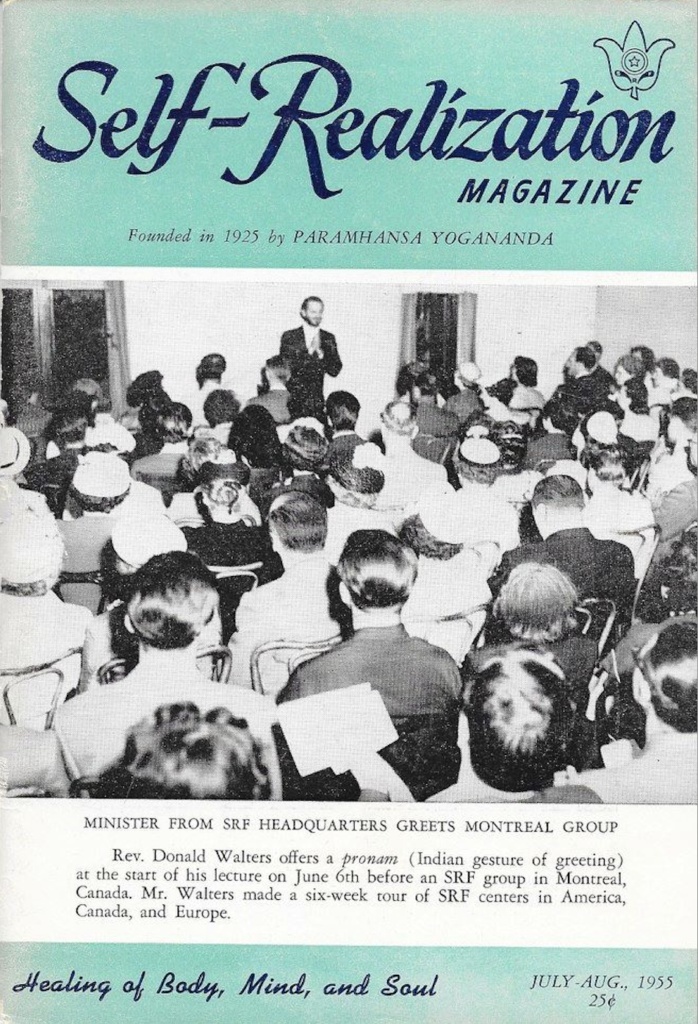
Rajarsi Janakananda also supported his expansive projects, which included streamlining the SRF office procedures.
In 1954, SRF sold a book authored by Kriyanada, Stories of Mukunda, advertising it in the Self-Realization Magazine. Having one’s book published was a rare honor, one which few disciples have received.
SRF in those years also sold an album, called Music For Meditation, with Yogananda’s Cosmic Chants sung by Kriyananda.
At SRF under Daya Mata (1955-1962)
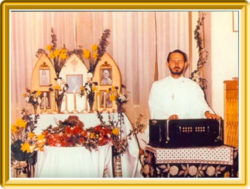 In 1955, he was ordained into the SRF Order by Daya Mata, receiving the name Brother Kriyananda. At the same ceremony were Brothers Bhaktananda, Bimalananda, and Sarolananda.
In 1955, he was ordained into the SRF Order by Daya Mata, receiving the name Brother Kriyananda. At the same ceremony were Brothers Bhaktananda, Bimalananda, and Sarolananda.
From 1955 to 1958, he was the minister of the SRF Hollywood Church (picture on the left).
Brother Kriyananda had the honor of sharing the podium with his Holiness the Shankaracharya Bharati Krishna Tirtha of Govardhan Math in Puri, during his public discourse in Los Angeles, in which 1200 persons attended. The Shankaracharya’s visit to the West had been sponsored by SRF.
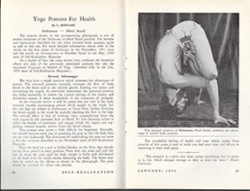 In SRF magazines from these years, one can see Brother Kriyananda demonstrating the yoga asanas in articles on Hatha Yoga. In Yogananda’s presence, he had frequently demonstrated the postures to visiting guests. Later on, he developed his understanding of the asanas into a Hatha Yoga system, now called Ananda Yoga.
In SRF magazines from these years, one can see Brother Kriyananda demonstrating the yoga asanas in articles on Hatha Yoga. In Yogananda’s presence, he had frequently demonstrated the postures to visiting guests. Later on, he developed his understanding of the asanas into a Hatha Yoga system, now called Ananda Yoga.
Here we can see Kriyananda and Dr.Lewis conducting a Kriya initiation in 1955.
The last four years within SRF: India (1958-1962)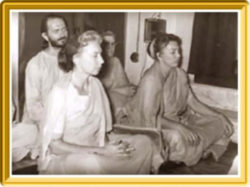
The larger part of Kriyananda’s final four years at SRF were spent in India. In August 1958 he went on a lecture tour to Fiji, Australia and New Zealand. Afterwards he joined Daya Mata in India. She had invited him to accompany her on a year-long tour throughout the country of their Guru, along with Ananda Mata and Sister Revati. During that year Baranagar was their home-base.
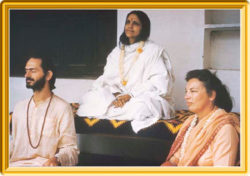 For one year (1958-1959) Daya Mata and Kriyananda traveled side by side through India. His job was to serve and support her.
For one year (1958-1959) Daya Mata and Kriyananda traveled side by side through India. His job was to serve and support her.
At the end of that year, Daya Mata and the other nuns returned home while Kriyananda stayed on in India. On behalf of SRF he started highly successful lecture “campaigns”. Hundreds, at times even thousands, came to his talks.
In April 1960 Kriyananda returned to Mount Washington for six months. He was appointed the new SRF Vice-President and was elected member of the Board of Directors. See the SRF magazine: Kriyananda SRF Vice President. The article says: “He was very close to Yoganandaji, who showered much love on him.”
Daya Mata, as President, and Brother Kriyananda, as Vice-President, spent much time together discussing the SRF work. Here Daya Mata and Swami Kriyananda are seen as a team. Here he lectures at the Hollywood Church, soon after his return. He musically accompanied Daya Mata during her public showings of films of their India tour.
In late September 1960, he returned to India. During the first leg of the trip Kriyananda travelled with Brother Anandamoy. Together they gave programs and Kriya initiations in Europe. In India he had a major plan in mind: the “Delhi project”. Daya Mata had given him her blessing to try to develop a big SRF center in the heart of Delhi. And he succeeded with the personal blessing of India’s Prime Minister, Jawaharlal Nehru.
Painful separation from SRF (1962)
His separation from SRF came as a sudden and devastating thunderbolt, but this is not how it happened exactly. It had been building up for a long time. The basic problem was, as Kriyananda describes: “[it was] as though I were perched on an erupting volcano in my own enthusiasm to build the work.” He acted from within, creatively, innovatively, instead of simply following orders. Yogananda had encouraged him in his enthusiasm and creativity. Rajarsi Janakananda, the second SRF president, had similarly supported him. Kriyananda flourished under these two men.
The difficulties started gradually with the leadership under Daya Mata. Now Tara Mata co-directed the organization. Daya’s sister Ananda Mata was influential too. Their direction was rather protective, trying to consolidate, protect, organize and regulate SRF. Kriyananda was the polar opposite. He viewed Yogananda’s mission in terms of dynamic and creative expansion, and therefore he continued to suggest, propose, initiate. In other words, he didn’t try to tone down his innovative ways and didn’t adapt to the new leadership and their priorities.
In short, Daya Mata and the others were following the guidance and training they had received from Yogananda, while the young Kriyananda (Daya was 17 years his senior as a disciple and Tara 24 years) “danced” to a different rhythm. Instead of following their directions, he followed the ones he had personally received from his Guru. Resistance, impatience, and frustration grew gradually stronger concerning his inability to simply follow what he was told to do. Daya Mata became increasingly impatient with him. Other senior nuns viewed him with suspicion.
Why, then, was he made Vice-president in 1960 if all this had been going on for over five years? Part of the reason might have been his impressive success in India. Another reason was (as Kriyananda writes) that Tara Mata saw his fitness for the role from his horoscope.
Swami Kriyananda offered two further explanations: “I suppose I was the natural choice anyway. I was the head monk, the director of center activities, and had been described a year earlier by Daya Mata as the senior minister of SRF. A man was needed for the Board, which otherwise would have consisted of only women.” (A Place Called Ananda).
In The New Path he offers a second explanation: “There was also, however, another way of looking at these promotions. Was I being ‘bumped upstairs,’ in a last ditch effort to make me ‘shape up’ and embrace those senior nuns’ priorities? If such was by any chance the case, it was a failure. I continued to follow my own understanding of the meaning and purpose of Master’s work. Considering my sheer inability to view the work as they did, they felt themselves left with no other option, I suppose, than to denounce me as a traitor.”
The “Delhi project” was when things came to a head. It was May 1961. Even though Daya Mata had blessed that project, it was now angrily rejected over the phone, by Tara Mata. Soon a letter arrived, written and signed again by Tara Mata, filled with severe accusations: “You wanted to get us so compromised with the Indian government that we’d have no choice but to go along with you. Your scheme was to split the work and set yourself up as the new guru in India. You lied to us. You connived for personal power. Your attitude reeks of personal ambition. You’re a megalomaniac, hypocritical, treacherous to the last degree.”
The letter struck Swami Kriyananda like a thunderbolt. Yes, he knew he was being criticized and under scrutiny, but this utterly condemning assessment of his character was a complete shock. He wept profusely and wrote back pleading not to be misjudged so completely. The answer he received was unrelentingly harsh.
From then on, for the following year, Swami Kriyananda spiraled down into ever greater disgrace. He describes his painful experience: “No matter what I did, I was told I should not have done it. And no matter what I didn’t do, I was told I should have done it. I was so utterly bewildered that I wondered if I understood anything anymore. Whatever I did or didn’t do was denounced categorically.”
Daya Mata, Mrinalini Mata and Ananda Mata (Mataji) visited India during that year, from July 1961-Jan. 1962. Their public success was considerable. Swami Kriyananda was frequently with them. Here are pictures of Daya Mata, Brother Kriyananda, Mataji, Mrinalini together.
Daya Mata wrote a letter back home to the Board of Directors, dated August 25, 1961 (published in by SRF as an Open Letter, 1995): “We talked with Kriyananda, pointing out to him all the complaints of the Board against his behavior… and we even made it clear that we were prepared, if necessary, to take steps to remove him from the Board.”
SRF clarifies in the same Open Letter “that it was not a subjective analysis that lead to his dismissal, but specific actions of his – his basic pattern of behavior – and that the situation was discussed with him on many occasions in the months before his departure.”
As soon as Daya Mata returned to Mount Washington, she was constantly subjected to Tara Mata’s demands, as she later told Kriyananda: “Tara worked on me for months, ordering me every day to get rid of you.” Finally she got her way. In July 1962, Kriyananda was called from India to New York (far from Los Angeles), for a meeting with Daya Mata and Tara Mata. Here the thunderbolt struck again, this time with even greater violence.
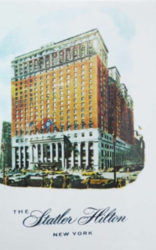 While in his room at the Statler Hilton (then Penta, now Hotel Pennsylvania), an envelope was shoved under his door. In it was a long letter written by Tara Mata and a number of letters by others, which contained accusations of the gravest nature. The letter concluded with the decision to ban him forever from SRF.
While in his room at the Statler Hilton (then Penta, now Hotel Pennsylvania), an envelope was shoved under his door. In it was a long letter written by Tara Mata and a number of letters by others, which contained accusations of the gravest nature. The letter concluded with the decision to ban him forever from SRF.
Completely devastated, he asked to see Daya Mata and Tara Mata. For two hours Kriyananda knelt in front of them, his hands crossed on his breast in an expression of unbearable anguish, unable to assimilate the enormity of this tragedy, pleading with them to reconsider their decision.
There was no mercy. Instead the devastating denunciations of Tara continued in the most violent manner (“You’d stop at nothing short of murder to get what you want!”). Daya Mata remained mostly silent and told him eight years later, “I never accepted the things Tara said against you.”
They asked him to sign the papers of resignation from the Board of Directors and from his position as SRF Vice-President, which he did. At the end he was handed $500 and was allowed to keep the $1000 he still had from his travel expenses.
On his own
In despair, Kriyananda now went to live with his parents. His life was in ruins, everything of value was lost: “For months I prayed fervently to be allowed to die.” He writes: “Hope seemed utterly lost to me. Ah, Master! For a time I even doubted your love for me – this perhaps worthless disciple whom you had, as I thought, completely abandoned. To listen to recordings of your voice, even to read your words, caused me almost unbearable pain. I clung mentally to your feet, and reminded you that I was yours eternally, even if you rejected me. But, I confess, in my intense loneliness I felt rejected.”
When he saw that his prayers to die were not going to be answered, he finally resolved to spend the rest of his days in seclusion and meditation. So, in 1963, he lived for half a year in a New Camaldoli Catholic monastery. Then he went on to a Ranch belonging to friends. For the next three months he lived in a cabin in Sedona, Arizona, living on 10$ a month. It was the bleakest time of his life.
Only with the passing of the years did he come to understand that what had happened was for his own good and for the good that Yogananda could accomplish for others through him. In January 1964, after much soul-searching, the turning point came. He wrote a letter to Daya Mata, ending it with these words: “I will work on, because I feel definitely now that this is what Master wants me to do. I am his disciple, and my life has been vowed to one purpose only: to serving him. While life lingers in this body, I will remain his child. And when I leave this form – bruised and beaten, if need be, in his service – I will remain his child, God willing, through eternity. Love, Kriyananda”
He now wrote his “maiden book”, today called Out of the Labyrinth: For Those Who Want to Believe But Can’t (his earlier book Stories of Mukunda was originally only meant to be a Christmas gift for the SRF monks). Yogananda himself had told Kriyananda that it was his task to write. Incredulously, he asked the Master: “Sir, haven’t you yourself already written everything that is needed?” Yogananda answered: “Don’t say that! Much more is needed!”
In 1964 Kriyananda also began to write songs, hoping through them to touch people’s hearts along with their minds. He soon recorded his first album, significantly called Say YES to Life.
In 1965 he began to teach classes on yoga postures and meditation in and around San Francisco. They were highly successful, being attended by up to 300 students a week. From the income, Swami Kriyananda was able in 1967 to buy a piece of land, which enabled him start his life mission: to create a spiritual community.
Building Ananda (1968)
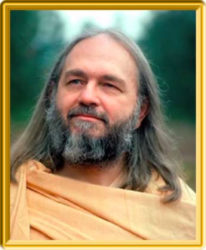 The crucial question is: did Yogananda know that the separation with SRF would happen? Did he maybe even want it to happen? Swami Kriyananda believed so: it was all divinely orchestrated and necessary. Within SRF it would have been impossible to do what Yogananda wanted him to do.
The crucial question is: did Yogananda know that the separation with SRF would happen? Did he maybe even want it to happen? Swami Kriyananda believed so: it was all divinely orchestrated and necessary. Within SRF it would have been impossible to do what Yogananda wanted him to do.
Indeed, toward the end of his life, Yogananda had told him numerous times with considerable earnestness: “You have a great work to do.” In 1954 Rajarsi Janakananda repeated to him the same thing, using the very same words, adding “and Master will give you the strength to do it.” Kriyananda, sensing the implications, the following day wrote Rajarsi a note: “I don’t want to do a great work! I just want to serve Master unnoticed.” Rajarsi’s response was to come and bless him again.
What did they mean by “a great work”? Now slowly some clarity emerged. Part of Yogananda’s mission was to build “World Brotherhood Colonies”. Kriyananda had heard him speak with enormous power about the necessity of building such colonies. “Deeply I vowed that day to do my utmost to make his words a reality.” The colonies were also part of Yogananda’s original “Aims and Ideals”, as these appeared in the 1959 8th edition of the Autobiography of a Yogi, which was presented as the final and complete version and contained all the changes the Master had wanted.
Swami Kriyananda was also present at the SRF Lake Shrine dedication in 1950 (a picture of it is shown above), which was a major event with the governor of California and the media present. Yogananda’s talk on that occasion was recorded and contains these significant words: “I am not starting churches or other new cults. I don’t believe in it… The greatest thing in the church movement is the building of colonies… Colonies where people can have their job, home, character-building, church, freedom, all at the same place.”
However, Daya Mata’s words to Swami Kriyananda were: “frankly, I am not interested.” They simply weren’t a priority for her. In the same Open Letter (see above), SRF quotes her words from a satsanga she gave in 1975: “He said to us that his mission was to bring the message of Kriya Yoga. There will be plenty of time in the future when such colonies and other ideas can be put into effect.” The Open Letter adds: “Self-sustaining SRF communities will come into being in the future, when the time is right.” Swami Kriyananda knew, however, that under Daya Mata they would never come into being.
Was Kriyananda supposed to follow what he felt and knew from Yogananda? Or should he follow SRF’s direction? Once again he followed his inner guidance, perceiving Yogananda’s blessings, presence and joy. Ananda was born.
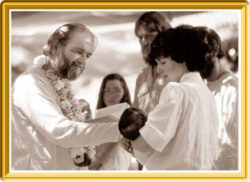 The whole odyssey of how Swami Kriyananda built Ananda, including the attacks he endured, can be read in Asha Praver’s book, Lightbearer. SRF never accepted Ananda as a legitimate branch of Yogananda’s work. It was viewed, rather, as a threat to Yogananda’s mission.
The whole odyssey of how Swami Kriyananda built Ananda, including the attacks he endured, can be read in Asha Praver’s book, Lightbearer. SRF never accepted Ananda as a legitimate branch of Yogananda’s work. It was viewed, rather, as a threat to Yogananda’s mission.
Kriyananda, on the other hand, felt that he was defending his Master’s mission and the spirit he had brought: few rules, personal creativity, individual inspiration. He maintained that just as Yogananda’s name and signature had been changed (from Paramhansa to Paramahansa, years after the Guru’s passing), so the whole free, expansive and visionary spirit of Yogananda had been lost. SRF had strayed far from his ways, he felt, having become highly institutionalized, much like a Western monastery. Ananda represented for him Yogananda’s living legacy, much more so than SRF.
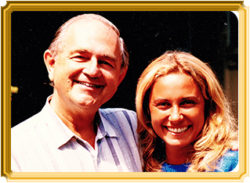 Kriyananda married twice. On the photo we see his wife Rosanna. Neither marriage lasted long, but he set the direction at Ananda for becoming a householder community, not a community of monastics. Earlier at Ananda the monastic tendency had prevailed.
Kriyananda married twice. On the photo we see his wife Rosanna. Neither marriage lasted long, but he set the direction at Ananda for becoming a householder community, not a community of monastics. Earlier at Ananda the monastic tendency had prevailed.
In 1990, SRF started a 12-year copyright lawsuit against Ananda. It was the outward escalation of tensions that had long been building up. The original Autobiography of a Yogi and other material were found to be in public domain. One of the SRF lawyers in 1994 spearheaded a second lawsuit about sexual harassment. It was heavy for all: Daya Mata, in a settlement meeting in Fresno, said: “I can’t face Master as long as this problem remains unresolved.” The pressure, at any rate, was high, but had a positive effect on Ananda: it strengthened and united the community by sheer necessity. It was David fighting against Goliath.
Some SRF representatives still held Kriyananda in high esteem. Brother Turiyananda (1926-1990), who had joined SRF in 1954, shared with Ananda members his fond memories: “I love Kriyananda. When he was here, there was such joy at Mt. Washington. Laughter rang through the halls.”
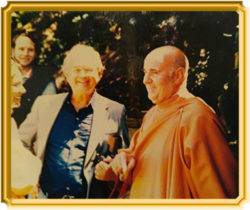
With Brother Turiyananda
Blessings and the support of saints
Also, many great saints in India gave him strong support throughout the years.
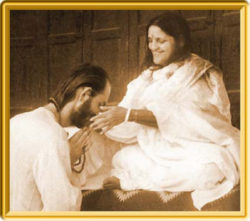 Ananda Mayee Ma told Kriyananda after his separation from SRF: “If you had asked to be allowed to come and stay here, you would have been made welcome.” Earlier, during his most difficult time, she had written him a letter, encouraging him: “Take this experience as your Guru’s grace!” And then these important words: “Always try to do your Guru’s bidding. Don’t accept suggestions from anyone that are in conflict with his bidding.”
Ananda Mayee Ma told Kriyananda after his separation from SRF: “If you had asked to be allowed to come and stay here, you would have been made welcome.” Earlier, during his most difficult time, she had written him a letter, encouraging him: “Take this experience as your Guru’s grace!” And then these important words: “Always try to do your Guru’s bidding. Don’t accept suggestions from anyone that are in conflict with his bidding.”
Satya Sai Baba, when Swami Kriyananda visited him, looked at him and said: “Very bad! Very, very bad! So many people have tried to hurt you. But don’t care for them. Just selfishness and jealousy! Don’t care for them. You are on the right path. And you are working selflessly! Oh, very, very bad! Even in religious work there is so much selfishness and jealousy. But you are pleasing your Guru. He is always in your heart. Just go your own way.” Sai Baba wrote this letter to Swami Kriyananda, which he kept on his altar.
Swami Muktananda told him: “It is easy to see just from looking at you that you are one who is centered in the Self.” He added this encouragement: “Ananda is the best ashram in America.”
Neemkaroli Baba, whose word was considered infallible, said that Swami’s dream to build a temple in Delhi would finally come true. “It will come up,” were his simple words.
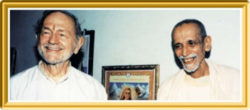 Swami Chidananda (successor of Swami Shivananda) was Kriyananda’s friend. They exchanged visits to each other’s ashrams. Their photo is shown here.
Swami Chidananda (successor of Swami Shivananda) was Kriyananda’s friend. They exchanged visits to each other’s ashrams. Their photo is shown here.
There were others, unknown saints like Rani Ma (a highly evolved Kriya Yogini) in Hardwar who said, when Kriyananda was thinking about establishing Ananda in India: “Swami Kriyananda is a very beautiful soul. Yogananda loved him very much, and has given him power. As soon as he thought of coming to India, his Master’s blessings were there. It would be my honor to have his darshan.”
The “volcano” of creativity
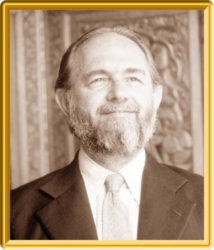 “Sitting on a volcano of creativity,” is how Swami Kriyananda described himself. He never stopped: he initiated a worldwide community movement, establishing Ananda communities in America, Italy and India; he founded a school system called “Education For Life”, based on Yogananda’s teachings; he wrote 140 books; he composed 340 pieces of music (including chants) and recorded many albums; he took 1500 photographs which express conscious beauty and which he used for inspiring slideshows; he wrote two plays; he painted several paintings; he created Ananda Yoga; he started various business ventures; he initiated the production of two feature movies, The Answer and Finding Happiness; and he founded the Nayaswami Order, which offers a new way of living renunciation. In addition to all this, Swami Kriyananda toured the globe, giving countless talks, satsangs and workshops.
“Sitting on a volcano of creativity,” is how Swami Kriyananda described himself. He never stopped: he initiated a worldwide community movement, establishing Ananda communities in America, Italy and India; he founded a school system called “Education For Life”, based on Yogananda’s teachings; he wrote 140 books; he composed 340 pieces of music (including chants) and recorded many albums; he took 1500 photographs which express conscious beauty and which he used for inspiring slideshows; he wrote two plays; he painted several paintings; he created Ananda Yoga; he started various business ventures; he initiated the production of two feature movies, The Answer and Finding Happiness; and he founded the Nayaswami Order, which offers a new way of living renunciation. In addition to all this, Swami Kriyananda toured the globe, giving countless talks, satsangs and workshops.
During Mrinalini Mata’s SRF presidency (2010-2017)
On May 10, 2011, almost exactly 50 years after his expulsion from SRF, Swami Kriyananda wrote a very personal letter to the new SRF president, Mrinalini Mata. It is certainly long, but perfectly sums up Swami Kriyananda’s life as a disciple and his greatest pain. The letter was hand-delivered.
Dear Mrinalini Mata:
In a little over a week I will be turning 85. I really would like if possible – indeed, I plead with you to help me – to clear up a few things while I am still in this body. You yourself have just turned – is it 79? Life passes quickly. Soon, it will be gone. And if these things are not resolved a golden opportunity will have been missed – for me, certainly; perhaps also for you. If they must be missed, then I will accept that that is how things are, but my own intense wish is for certain things to be cleared between us before I “shuffle off this mortal coil.” I will try in these pages – which may be long; please forgive me – to be completely truthful and honest with you, and at the same time to express the deep respect I feel for you, at least as a fellow disciple of our great Guru.
I will tell you at the outset that I feel no resentment against you, nor against Daya Mata, nor against Tara Mata. It may have looked to you all as though my actions had been motivated by a spirit of rivalry with you. I can solemnly state before God and Master that such has never been the case.
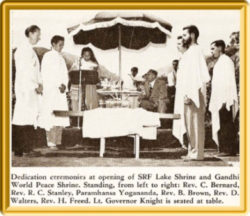 That I have always been a good and loyal disciple of Master I will not claim, for it is up to him to make that assessment. This much I can claim, however, and I do so sincerely: I have done my humble best to serve him in this lifetime, and to the very best of my capacity. I do not consider that anything I have done is important, except as it has served to promote his message and his mission in the world. When I come before him, after this life passes, the only question I expect him to ask me is, “Have you loved me?” And I earnestly hope to be able to say to him with all my heart, “You are all I have ever loved.”
That I have always been a good and loyal disciple of Master I will not claim, for it is up to him to make that assessment. This much I can claim, however, and I do so sincerely: I have done my humble best to serve him in this lifetime, and to the very best of my capacity. I do not consider that anything I have done is important, except as it has served to promote his message and his mission in the world. When I come before him, after this life passes, the only question I expect him to ask me is, “Have you loved me?” And I earnestly hope to be able to say to him with all my heart, “You are all I have ever loved.”
In New York at the Penta Hotel, when Tara and Daya called me in for their final confrontation with me, I knelt on the floor before them with my arms crossed over my chest, pleading with them from my heart not to reject me. Tara sternly refused. When I said to her, “But none of these things you’ve been saying against me are true!” she answered contemptuously, “I don’t want your opinions!” Will you answer me the same way? If that is what is in your heart, I invite you to do so. I am completely open to anything you say. I may not agree with you. But I want, if possible, to clear the air of any and every misunderstanding between us.
For I must tell you, my separation from SRF has been the one deep, ineradicable hurt in my life. It has never made me angry. It has never made me resentful. It has never awakened in me the thought, “Well, I’ll show you!” I deeply and sincerely loved Daya Mata, and also Tara Mata. I was hurt to my very core by their rejection of me. I wanted to understand whether there had been any truth in the accusations they hurled against me. For many years I suffered deeply on that account, and I suppose the pain will never completely leave me – though I am grateful to say that I also feel increasing bliss in myself. But that persecution – for that is what it has been – has been heartrending, considering that it came from the two people in this world whom I had long considered my best friends and advisors.
Daya seems to have felt almost a compulsion to destroy me. Why? What did I ever do to offend her? I estimate that she spent some fifty million dollars through those lawsuits, only to encompass my destruction – as if what they’d done to me in New York had not been enough to shatter me utterly. I am her brother. I’ve been her brother in other lives also. Why this need to bring about my utter ruin?
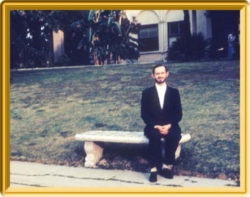 You yourself, Mrinalini, wrote in your letter about me to the Board in 1962, “Kriyananda has the greatest ego I’ve ever seen.” What a strange thing for me to hear! I had always thought so very highly of you. Have I such an ego? I myself am not aware of it. I don’t consider that I even matter. Sometimes I’m not so sure I’ve done anything meritorious at all. But I can say this: One time, when Master was speaking to us about the men teachers who had fallen due to ego, I said to him, “That’s why I don’t want to be a teacher, Sir.” He answered me calmly, slowly, and very firmly, “You will never fall due to ego!”
You yourself, Mrinalini, wrote in your letter about me to the Board in 1962, “Kriyananda has the greatest ego I’ve ever seen.” What a strange thing for me to hear! I had always thought so very highly of you. Have I such an ego? I myself am not aware of it. I don’t consider that I even matter. Sometimes I’m not so sure I’ve done anything meritorious at all. But I can say this: One time, when Master was speaking to us about the men teachers who had fallen due to ego, I said to him, “That’s why I don’t want to be a teacher, Sir.” He answered me calmly, slowly, and very firmly, “You will never fall due to ego!”
In other ways, too, you have not been square with me. I beg you to be so now. You have tried – I won’t mention the exact circumstances, though I could do so – to silence me by equivocation – you, who are an essentially truthful human being. Always, I have understood what you were doing. But I have remained silent. It just isn’t in my nature to argue; to do so is both foolish and undignified. But please be straight with me. If you are not, I shall understand. And if you try simply to silence me with a true but irrelevant sentence, I shall understand. And if you say nothing at all, I shall understand. I shall understand, yes. But I shall carry the pain to my grave.
The only thing I could not accept was Tara’s firm commandment to me in New York never to do anything again to serve Master. My life was committed wholeheartedly to his service. How could I serve him, then, by doing nothing? She said to me, “Just take any job that comes along.” I would have died rather than work only for my own support. In fact, for many months I prayed for exactly that: to be allowed to die.
You wrote me once, several years later, as if to hold up Binay Dubey as an example for me, telling me that he had served Master up to his dying breath. You’ve no idea how deeply that wounded me – when I myself had been debarred from serving him at all.
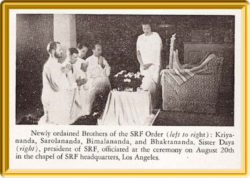 Tara’s statement to me in New York was, “From now on, we want to forget that you ever lived!” But I am your brother – the same to all of you! Ah! the pains I have gone through over this rejection by my own dearest ones on this earth!
Tara’s statement to me in New York was, “From now on, we want to forget that you ever lived!” But I am your brother – the same to all of you! Ah! the pains I have gone through over this rejection by my own dearest ones on this earth!
No, I have never tried to rival you. But I have always been sitting as if on a volcano of creativity. I can’t help it. That’s how I am made. It would take much more effort to suppress this volcano than simply to let it erupt.
Brother Bhaktananda used to be a bit jealous of me (I think so, anyway) for my creativity, but I myself, though I loved him for his devotion and humility, was also a bit envious of him for what I perceived as his lack of creativity! I used to think, “Maybe, if I were more like him, I could devote myself to a more meditative life.”
But Master himself urged me in my own natural direction. He said to me, “Your life will be one of intense activity, and meditation.” But he put meditation second. You all used to wish I were different. I myself wished I were different! But I simply was who I was. I wasn’t trying to prove anything. Tara called me a megalomaniac. I’ve never considered myself at all important. But Master’s message has always been, for me, one of world-uplifting importance. I am completely dedicated to making the world know – not him; that would be ego on my part; but the truths and the enormously vital message he brought to mankind. I have tried humbly – yes, I feel I may claim that – and very sincerely to make that message known in the world. That I have succeeded to some extent in that effort, and – indeed – far more so than SRF has done, I don’t see as a matter for pride. I have simply thrown myself into my service to him. In many ways, I must admit, it has been a great help to be able to do these things on my own, without the need for committee approval.
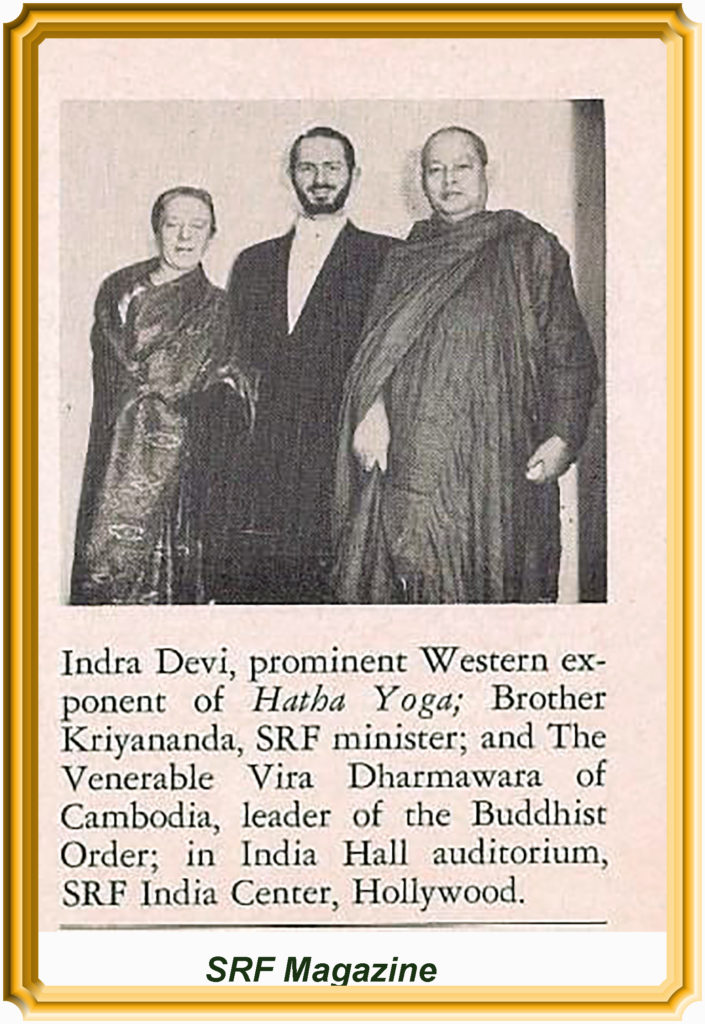 Master was about to go out one day by car. Herbert Freed and I were standing nearby. Master was giving him some last-minute advice for his new appointment as minister of the Phoenix church. At a certain point, he paused a moment, then said, “You have a great work to do.” I naturally turned to Herbert with a gaze of felicitation. But Master corrected me. “It’s you I’m talking to, Walter,” he said. Weren’t you in the car then?
Master was about to go out one day by car. Herbert Freed and I were standing nearby. Master was giving him some last-minute advice for his new appointment as minister of the Phoenix church. At a certain point, he paused a moment, then said, “You have a great work to do.” I naturally turned to Herbert with a gaze of felicitation. But Master corrected me. “It’s you I’m talking to, Walter,” he said. Weren’t you in the car then?
From then on he often said such things to me. “You have a great work to do, therefore . . .” Or, “Because you have a great work to do, you mustn’t . . .” Usually, when he said such things, we were alone together.
I once mentioned to Daya Mata that he had told me I had a great work to do. “Yes,” she replied, “we all have a great work to do.” But that wasn’t how he had spoken those words to me.
One time we were alone outdoors at his desert retreat. Suddenly, as if out of the blue, he said, “Apart from Saint Lynn, every man has disappointed me.” Then, with deep intensity, he said almost fiercely, “AND YOU MUSTN’T DISAPPOINT ME!”
I knew his meaning couldn’t have been that all the men had disappointed him spiritually, for some of them were deeply devout. What he had meant was that he saw in me a deep zeal to make his message known to the world. Masculine energy is more outward; feminine, more inward. Masculine energy was what his work needed, to become widely known.
Mrinalini, I don’t know whether any point can be served by my saying more. There is infinitely more I could write, and I would love to do so. But I do want, from my deepest heart, to resolve any misunderstanding that exists between me and you. I love all of you deeply, and consider you my own. I am not interested in any organizational reconciliation or justification. I know what I have done for Master. I feel his satisfaction with me in my heart. I am willing to be scolded by him for anything I’ve done wrong. I’m willing to accept his judgment, should he care to deliver it, that my whole life has been wasted. I hope it has not, but the judgment is his to make. I would just like to feel that these deep hurts I hold in my heart can be resolved. I have nothing to defend. All I feel is the desire to be open to you – and, yes, to let you stab it again and again, if that be your desire, even asTara and Daya did. Cut me to ribbons, if you like. I am willing, in other words, to sustain any hurt, if necessary, in my effort to bring about some reconciliation between us – even 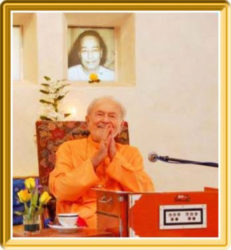 a slight reconciliation, but on a heart-to-heart level. I have not written this letter in a spirit of repentance, for I feel I have lived my life honorably as Master’s disciple. I have done my very best always, through all tempests and storms, to please him.
a slight reconciliation, but on a heart-to-heart level. I have not written this letter in a spirit of repentance, for I feel I have lived my life honorably as Master’s disciple. I have done my very best always, through all tempests and storms, to please him.
You have never answered any of my letters in the past. I hope you will answer this one.
With deep, humble, and self-effacing love for Master,
swami kriyananda
The letter has never been answered or acknowledged.
Moral for devotees
Yogananda said, “When I am gone, only love can take my place.” It’s easy to love one’s own fold. But what credit is that to us? SRF and Ananda are two folds with very different mind-sets, undoubtedly. But if they can’t find a way to create a sense of goodwill and harmony between them, of reconciliation, the world will receive a very poor testimony of the power and validity of Yogananda’s teachings.
The Master said humorously: “In this world, we are all a little bit crazy, and we don’t know it, because crazy people of the same kind mix with the same kind of crazy people. When people differently crazy come together, then they find out about their own craziness.”
Especially for the younger generation: won’t friendship and harmony among two differently crazy folds be the attitude which the Master will bless and advocate?
Kriyananda’s passing
“Will I find God in this life?” Kriyananda once asked Yogananda. The Master answered: “Yes. But don’t think about it.” After a pause he continued, “After many lifetimes, everything has balanced out now.” He later told him: “God won’t come to you until the end of life. Death itself is the final sacrifice you’ll have to make.”
For the Easter 2013 celebrations Swami Kriyananda had come to the Ananda Assisi community. From there he wrote his final letter to the entire Ananda spiritual family. Here is an excerpt:
“Dear Ones:
I wish I could bless each and every one of you with a happy Easter. Easter is a time symbolizing the eventual resurrection of our little, individual selves into the one, Infinite Self. I suggest at this time particularly that you study and meditate on the photograph of Master titled The Last Smile. And consider this amazing fact: He knew that in just a few moments he would be leaving his physical body forever! There is no thought of self in his eyes, of personal regret, of sorrow. Clearly visible in his eyes and in his facial expression is his unconditional love for all mankind; his readiness to return ‘again and again,’ as he put it, as long as one stray brother sits weeping by the wayside. Such love, for ego-centered humanity, is not even conceivable. And this was the love Jesus, too, felt for all humanity…. If we must resurrect our souls, let it be from the delusion that anything in this cosmic dream holds some worthwhile reality for us. We are children of God: That is our sole reality!
Love, swami”
Soon afterwards, on Sunday April 21, 2013, Kriyananda left his body in Assisi, aged 87. As it happens, both his entrance and his exit in this world occurred on a Sunday, the Lord’s day.
He died as he lived: serving. He was sitting at the computer, answering letters. Then he briefly sat down at the dining table intending to have breakfast. His body had had a long history of painful troubles. Now he had a small seizure and that was enough. Soon everything was over.
The Book of Brighu (ancient book of prophecies) had told him that he would attain moksha (final liberation) in this life: “It is definite that he will attain moksha for I tell you truly, his motives are pure.” Yogananda’s words were that he would find God, and that it would occur at the end of his life.
That moment was now. His soul rose into eternal freedom.
